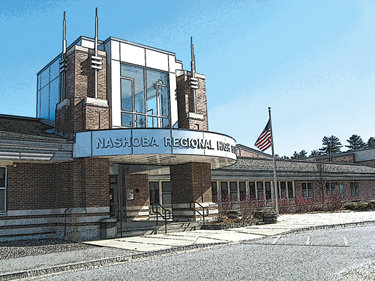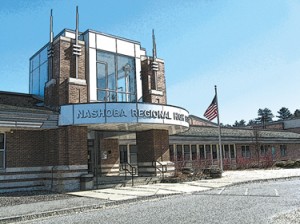
by Ann Needle 
The annual Budget Workshop at last Wednesday’s Nashoba School Committee meeting offered more details into the district’s 2015/16 spending plan. It also fielded questions about the direction Nashoba is taking.
If approved, the budget would be up about 5.05% over 2014/15, or about $2.5 million, reported Superintendent Michael Wood. This contrasts with hikes of under 4% in each of the last two years. As for assessments, Stow’s portion of the budget would go up almost 7.5%, to roughly $16,114,631.
Each Nashoba department offered its insights into what it plans to do with its portion of the more than $53 million plan. In the System Wide budget, Assistant Superintendent George King remarked that not a lot has changed over the past year. The Insurance and Benefits lines remain one of the biggest piece of that budget. He noted that health insurance is “always a potential budget buster,” with increases running as high as 20%. However, he pointed out that this year’s hike should stay around 5%.
Director of Human Resources Monica Visco focused on the additional instructors requested.
Special Education is planning to add a SPED team chair. “There’s just such a need for it right now,” Visco remarked. According to Michael Wood, the number of students eligible for SPED services rose from 407 in 2011, to 473 this year.
Wood explained the chair would take care of initial student evaluations for SPED services. He noted that about 70 students have needed assessments already this school year. The chair should help keep the assessment process for each child within the legally-mandated 21 days, Wood added.
In that vein, Center School is slated to receive a full-time SPED educator for grades 3 through 5. The plan also includes a full-time Math specialist. Hale Middle School should be adding another teacher to grade 6’s large incoming class of 113.
NRHS would be adding part-time positions in Business, Social Studies, and Theater Arts. Looking at average enrollments per classroom for each subject, Lancaster Rep. Cathy Thiel remarked that she found it concerning that half of the high school’s math classes contain at least 21 students. NRHS Principal Dr. Parry Graham explained that this was partially a trade-off to increase the number and variety of courses offered.
Under the district-wide Facilities Budget, Stow Rep. Lynn Colletti questioned why $145,000 was budgeted to install the Pompsitticut modular classroom unit at the high school after the SC voted to keep the cost under $100,000. George King said the higher estimate would be the cost if all moving and installation work was contracted out, but he expected most work to stay in-house.
Technology/Media CIA Coordinator Cynthia Larsen told the SC that the district is currently looking into what benefits could come from putting an internet-connected device into each student’s hands, such as a laptop or tablet. “I keep hearing from teachers, ‘We have four or five Chromebooks in the class, when can we all have them?’”she said.
Nashoba has been circulating batches of these computer-like Chromebook laptops around district schools, while every child is allowed to bring their own electronic device to class. This “BYOD” policy and shared Chromebooks were seen as less expensive than following the lead of some local districts by purchasing a device for each student.
Larsen listed advantages of a device for every student such as carrying work from grade to grade in an “electronic portfolio,” and lowering the achievement gap between different groups of students (so long as teachers are properly trained). She acknowledged that teachers also need to guide students in reading online text for deeper meaning. “As soon as you put a screen in front of people, they skim,” she said. But, 21st century learning still calls for students to master technology, Larsen stressed.
The budget calls for starting a one-to-one initiative with Chromebooks for each Nashoba eighth grader, estimated at about $78,000 for 260 devices. Larsen explained that these have proven to be low cost and easily maintained.
Where to Now
Unlike in recent years, the SC did not focus on trimming the budget, but on what the district should be spending on.
Comparing her rough calculations of per-pupil spending by Nashoba with other Massachusetts districts, Stow Rep. Nicole Odekirk asserted, “We are well within the norm. We should be well above the best school district in the state.” Going through the spending plan, she said, “I can’t say I’m excited. I don’t want to give any more.” Lancaster Rep. Julie Fay agreed, commenting, “I feel like we’re getting the bare minimum.”
Odekirk also suggested “redefining SPED” to include enrichment for students considered gifted and talented. “Coming from another state, I can’t believe, of all states, Massachusetts doesn’t have a gifted and talented program. Why can’t we be the district that defines it?” she asked. “If a kid is going from grade to grade, it seems [we think] our job is done.”
Michael Wood countered that the growing enrichment menu in the district is targeted to all students, “And we ask, where can we find more opportunities to enrich kids at each level?”
Overall, Oderkirk, added, “If we just feel like we should budget just for what we need, then we aren’t moving forward.”
However, SC Chair Nancy Federspiel of Bolton cautioned the SC that Nashoba’s towns may have a tough time with the +5% budget increase, given the lower increases of previous years.